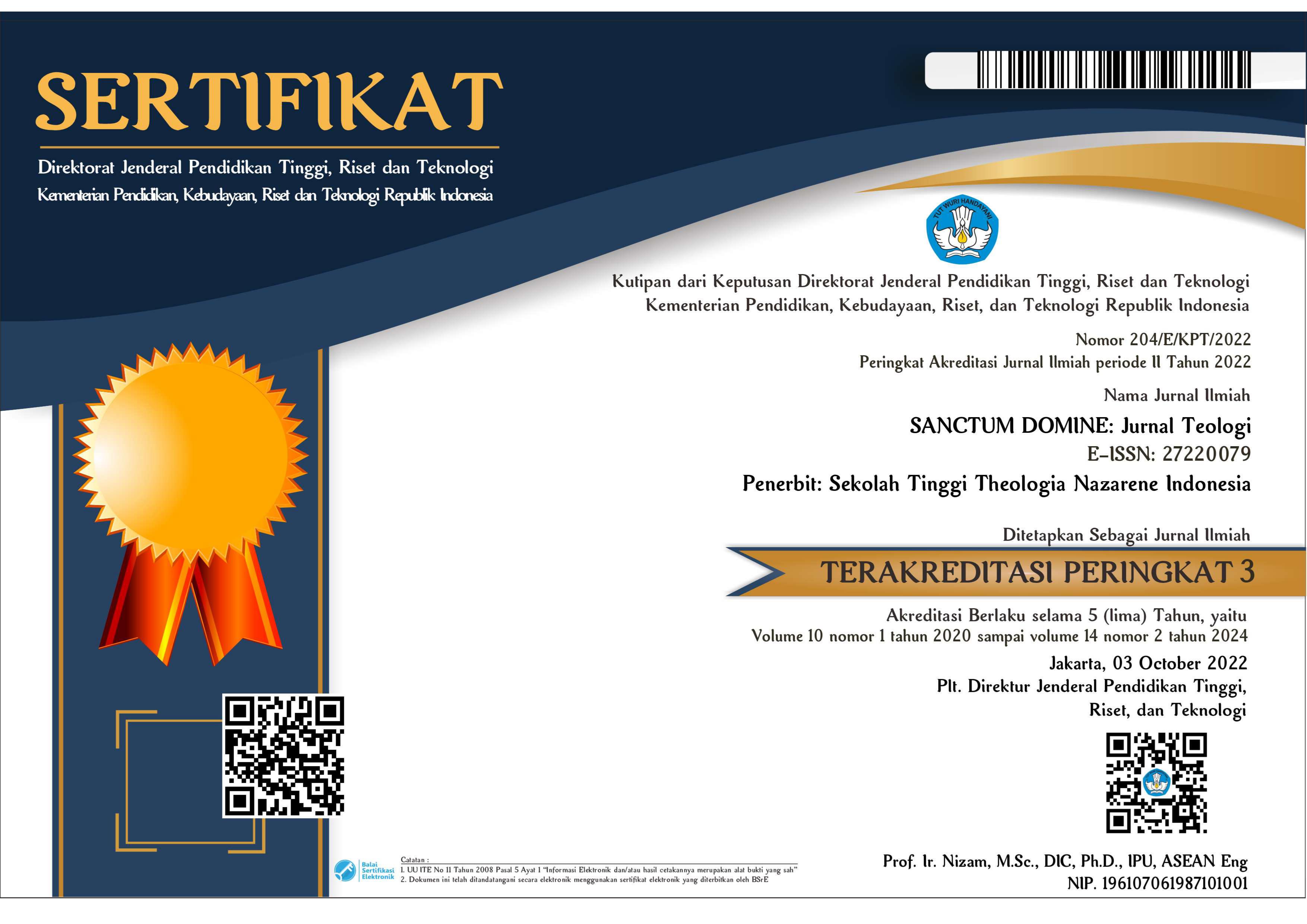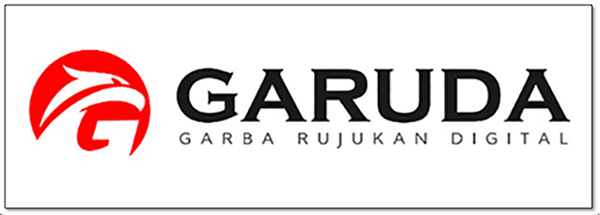The Correlation between Religious Focus Coping and Burnout Due to Covid-19 Experienced by Christian Parents in West Bandung
Abstract
Burnout is a serious threat to Christian parents due to Covid-19, because it can impact physical, emotional, and behavior that is not educating and assisting children effectively but can damage children's mentality. This study examines the relationship between religious focus coping and burnout in Christian parents in West Bandung. Data analysis using bivariate correlations technique with sampling technique using stratified random sampling. Because the population is unknown for certain, the minimum number of samples is 10 x the number of variables to determine the number of samples using the Roscoe formula. This study uses two variables, namely religious focus coping and burnout. Thus, the minimum number of samples should be 20. In this study, 43 Christian parents were involved, meaning that the specified number of samples met the requirements. The results showed that the correlation coefficient of religious focus coping with burnout was -0.495, which was strong enough. While the coefficient value marked - (negative) means that burnout is reduced or decreased due to high religious focus coping. The significance of the correlation was 0.001, smaller than the significance of alpha > 0.05. Because the significance of 0.001 is less than 0.05, hypothesis 0 (Ho) is rejected, while the alternative hypothesis (Ha) is accepted. This means a significant correlation or relationship exists between religious focus coping and burnout of Christian parents.
References
Aunola, K. Sorkkila, M. and Tolvanen, A. “Validity of the Finnish Version of the Parental Burnout Assessment (PBA).” Personality and Social Psychology. Scandinavian Journal of Psychology, 61, (2020): 714-722.
Cohen, A. B., and H. G Koenig. “Religion and Mental Health.” Encyclopedia of Applied Psychology 3 (2004).
Firdaus, E. Z., Noermijati, Ratnawati, K., and Zaroug. The Role of Job Burnout and Social Support on the Effect of Job Demand to Employee Performance. Jurnal Aplikasi Manajemen, Volume 21, Issue 1, (2023): 42-56.
Folkman, S, and Lazarus. R “Coping as a Meditation of Emosion.” Journal of Personality and Social Psychology 54, no. 3 (1988): 466–475.
Griffith, A. K. “Parental Burnout and Child Maltreatment During the COvid-19 Pandemic.” Journal of Family Violence (June 23, 2020).
Karnesya, A. “Kenali Parental Burnout, Kelelahan Bunda Mengasuh Anak Selama Pandemi.” HaiBunda.com, 2021.
Martinez, J. P. Mendez, I. Ruiz-Esteban,
C. Fernandez-Sogorb, A. and
Garcia-Fernandez. J.M. "Profiles of
Burnout, Coping Strategies
Depressive Symptomatology".
Frontier in Psycholody 11 (2020).
Maslach, C. and Leiter, M.P. "How to Measure Burnout Accurately and Ethically". Harvard Bisnis Review, Health and Behavioral Science. (Maret 19, 2021).
Mulyadi, S, H Basuki, and H Prabowo. Metode Penelitian Kualitatif Dan Mixed Methode. Depok: Rajawali Press, 2019.
Pargament, K. I., M Feuille, and D Burdzy. “The Brief Scope: Current Psychometric Status Og Thr Short Measure of Religious Coping.” Religious Journal 2 (2011): 51–76.
Pirutinsky, S. Cherniak, A.D. Rosmarin,
D. H. “COVID 19, Mental Health,
and Religious Coping Among
American Orthodox Jews”. Journal of
Religion and Health (2020) 59:2288–
Roskam, I, M. E. Brianda, and M Mikolajczak. “A Step Foward in the Conceptualization and Measurement of Parental Burnout: The Parental Burnout Assessment (PBA).” Frontier in Psychology 9 (2018): 758.
Schaufeli, W. B., and A. B. Bakker. “Job Demand, Job Resources, and Their Relationship with Burnout and Angangement: A Multi Simple Study.” Journal of Organisation Behavior 25 (2004): 293–315.
Shirom, A. “Epilogue: Mapping Future Research on Burnout and Health.” Stress & Health 25 (2009).
Sugiyono. Metode Penelitian Administrasi: Pendekatan Kuantitatif, Kualitatif, Dan R&D. Bandung: Alfabeta, 2021.
Wardani, Anita, and Ayriza, Yulia. “Analisis Kendala Orang Tua Dalam Mendampingi Anak Belajar Di Rumah Pada Masa Pandemi Covid-19.” Jurnal Obsesi: Jurnal Pendidikan Anak Usia Dini 5, no. 1 (2021): 772–782.
Copyright (c) 2023 SANCTUM DOMINE: JURNAL TEOLOGI

This work is licensed under a Creative Commons Attribution-NonCommercial-ShareAlike 4.0 International License.
Copyright:
SANCTUM DOMINE: Jurnal Teologi will validate, produce, disseminate, and act as steward in the long-term curation of every article published. In order to achieve this, the author typically requires a transfer or “assignment” of the copyright in the article. As is the case for open access publishing, the author (or copyright owner of the article, if different) signs an author publishing agreement. The agreement incorporates the necessary transfer of copyright.
After assigning copyright, the author will still retain the right to:
- Be credited as the author of the article.
- Own and exercise any trademark or patent rights held by author and addressed in the article.
- Make printed copies of the article to use for a lecture or class that the author leading on a non-commercial basis.
- Share the article with friends, colleagues and influential people the author would like to read the work.
- Present the article at a meeting or conference and distribute printed copies of the article on a non-commercial basis.
License:
This work is licensed under a Creative Commons Attribution-NonCommercial-ShareAlike 4.0 International License.
You are free to:
- Share — copy and redistribute the material in any medium or format
- Adapt — remix, transform, and build upon the material
- The licensor cannot revoke these freedoms as long as you follow the license terms.
Under the following terms:
- Attribution — You must give appropriate credit , provide a link to the license, and indicate if changes were made . You may do so in any reasonable manner, but not in any way that suggests the licensor endorses you or your use.
- NonCommercial — You may not use the material for commercial purposes .
- ShareAlike — If you remix, transform, or build upon the material, you must distribute your contributions under the same license as the original.
- No additional restrictions — You may not apply legal terms or technological measures that legally restrict others from doing anything the license permits.
Notices:
You do not have to comply with the license for elements of the material in the public domain or where your use is permitted by an applicable exception or limitation .
No warranties are given. The license may not give you all of the permissions necessary for your intended use. For example, other rights such as publicity, privacy, or moral rights may limit how you use the material.



8.png)









